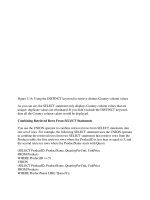Tài liệu Corporate Finance handbook Chapter 3 ppt
Bạn đang xem bản rút gọn của tài liệu. Xem và tải ngay bản đầy đủ của tài liệu tại đây (169.71 KB, 30 trang )
Part Three
Private Equity
3.1
Trends in Private Equity
Michael Joseph
Lloyds TSB Development Capital
New sources of money
Over the past decade there has been increasing acceptance of private
equity as an asset class for fund managers. Although UK fund man-
agers have yet to commit as much as US fund managers to private
equity (private equity is 0.5 per cent of asset allocation in the UK
versus 2 per cent in the US), this recognition has created enormous
growth in the sector. It has been driven primarily by the very strong
returns made by private equity investors, particularly as a result of
seeing private equity funds buying cheap as the economy came out of
the last recession, then make fabulous returns on flotation or trade sale
at the top of the market. There is now £41billion worth of investment
under management in the private equity sector (according to the
British Venture Capital Association).
This growth has a number of implications:
1. There has been a tremendous swing towards managing money for
other people, as opposed to own-balance sheet finance. The differ-
ence between own-balance sheet funds and managed funds is that
managed funds have to be returned to their owners at some stage.
If a portfolio has to be liquidated according to a fixed timetable, then
those managing the investment will naturally want to pursue
opportunities which offer short-term gains rather than long-term
gains, and gains which can be easily realised.
2. Funds are getting bigger. The natural response to this is to look for
bigger opportunities. The result has been that competition for the
largest buy-outs is very tight.
3. Funds are looking to Europe for opportunities. As the UK private
equity market has become more competitive, the European market
has begun to look very attractive.
The result of these three trends is that the sources of capital available
to you if you are running a small to medium-sized enterprise (ie up to
£30m value) have probably declined.
Furthermore, within the SME sector the trend has been towards
management buy-outs and buy-ins, because there is a perception that
the returns are great and the risks are small. It is also easier to engineer
an exit from a buy-out within a short timescale. The result is that most
of the venture capital funds available have been going towards
restructuring ownership rather than enabling entrepreneurs to grow
their businesses.
Less money is invested in development or expansion in the UK
than in the US. This has meant that the willingness of quality man-
agement to go into start-ups and developing the potential of SMEs
is very much less than it is on the other side of the Atlantic. The
British venture capitalist is not a venture capitalist in the true sense
of the word.
While the big funds in the UK market have been concentrating on
big deals and looking to Europe, this has not necessarily been a total
success for all concerned.
The unanswered question about the current European environ-
ment is whether the deals that have been done will generate liquidity
within the time frame of the funds. It is still doubtful whether funds
devoted to France and Germany are making an adequate return on
capital now, ten years or more after the market was first opened up. If
there are any winners they will be in the big ticket deals.
The downturn in 2001 will have a knock-on effect on the private
equity sector. In times of financial turmoil, people launching new
funds will find it harder to make their targets. It should be remem-
bered that historically a downturn has been a very good time to invest
in private equity. The three to five year time horizon means that one is
buying at the bottom of the cycle and selling at the top.
The tax environment is now very much more favourable to
venture capital investment, both at the institutional level and
84 Private Equity
the individual level, than it was ten years ago. This alone may be
enough to ensure that private equity prospers in difficult times.
It is unlikely that fund managers will reduce the assets allocated to
private equity because of short-term conditions in the public markets.
There is now an awareness of entrepreneurialism. Most people now
want to work for themselves. There is no longer any security in a big
company. There is a wide appreciation of the benefits of equity own-
ership. It has been a quiet entrepreneurial revolution. It is not going to
turn back.
Trends in Private Equity 85
Case study
Lloyds TSB Development Capital (LDC) and SMEs
Lloyds Development Capital’s view of the market is different
from many of its competitors. It has concentrated on the UK and
on the SME market within the UK. It has no intention of raising
outside funds, so it can take a slightly longer-term view of its
investments than it would have to if it were operating a closed
end fund.
As part of its strategy of supporting SMEs, it has been diversify-
ing its activity outside London. It now has offices in Nottingham,
Reading, Leeds and Birmingham, as well as the capital.
Over the last few years, LDC has become one of the largest and
most active venture capitalists in the UK (it is the leading investor
in the mid-market sector). It has invested in over 350 businesses
in its 20-year history, recently investing £105 million in 25 deals in
2000 and £115million in 27 transactions in 2001.
Typical of the type of deal it gets involved in is Encon.
The Encon story
In 1987, LDC led an equity syndicate of five members which
invested £2 million of risk capital in the Encon Group. Encon, a
private company, was then a distributor of insulation materials
with a small number of depots in the UK and a contracting/instal-
lation subsidiary.
86 Private Equity
Encon’s trading track record, pre the equity investment, was as
follows:
£ million
y/e 31August 1985 1986 1987
Sales 1.5 4.0 12.2
PBT 0.06 0.2 0.37
The equity funding of £2 million, along with £5 million of over-
draft and loan funding provided by Bank of Scotland, enabled
Encon to purchase the assets of two moribund insulation manu-
facturing plants in Scotland. The plants were acquired for a
knock-down price of £850,000 (the full replacement costs of the
assets would have been many millions) and the balance of the
total £7 million of funding was used to cover:
(i) re-start of the plants, including additional engineering capital
expenditure;
(ii) working capital to cover the planned growth of stock and
debtors for the expansion in group trading activities.
The equity investors obtained an equity stake of 22.5% in the
Encon Group.
The next three years (1988–90) were years of real achievement.
The manufacturing businesses produced quality products and
won market share in a tough sector. The Group also made a
number of acquisitions with the assistance of additional bank
funding. The largest of these helped to double the size of its dis-
tribution business to 20 depots. Encon’s first overseas depot was
also opened in France.
The business then grew rapidly:
£ million
y/e 31 August 1988 1989 1990
Sales 19.0 31.0 60.0
PBT 0.232 2.0 2.7
The benefits from rationalisation of the cost base following the
acquisitions were still to come through. The business looked to be
on track to achieve a full stock exchange listing in line with the
Trends in Private Equity 87
aspirations of Encon’s senior management and the investing
institutions.
By 31 August 1990, Bank of Scotland had increased its support
to £12 million (split equally between overdraft and term loan)
secured primarily by good book debts of £17 million.
To strengthen the balance sheet, the equity investors ‘followed’
their initial stake with a second stage capital injection of £3 mil-
lion in December 1990, which was used to reduce some of the
bank debt. The investors increased their equity stake to 32.5% in
the process.
The trading year 1990–91 proved to be the most difficult one in
the Group’s relatively short history. The UK economy weakened,
moving from ‘slowdown’ status to an ever deepening and seem-
ingly endless recession. The building construction sector suffered
enormously. Housing starts fell rapidly, new commercial builds
halted and, not surprisingly, the price of building materials fell.
Encon fought hard to maintain its market share, but with
prices falling and bad debts increasing it soon became impossible
to make sufficient earnings to cover fixed overheads. A pro-
gramme of rationalisation was begun during the trading year, but
this involved closure costs of circa £1 million. In the year end
31 August 1991 the following trading result ensued:
Sales £71.0million
Loss (£3.1million)
The compounding effect of very high interest rates on a highly
geared business dependent on the construction sector during an
economic recession was graphically illustrated in that result.
LDC, as lead investor, maintained its belief that Encon, by now
a sizeable player in its market, still had considerable unrealised
potential. With hindsight, Encon’s management had made some
strategic errors during the previous growth phase. But the team
were intelligent, receptive, hardworking and motivated to
restore company performance – though it was recognised that
any turnaround would take two to three years.
A series of meetings took place between management/
investors/Bank of Scotland and it became clear that Encon
required a further capital injection to see it through the recession.
88 Private Equity
The Bank of Scotland exposure had, by now, increased to £13 mil-
lion (split equally between overdraft and term loan) but Encon’s
debtor book had fallen to £16 million, and the Bank’s cover was
reducing.
LDC succeeded in arranging third-round funding of £3.5 mil-
lion from the syndicate (although at this stage one investor
dropped out). The total equity from the investors increased to
£8.5 million, and their equity stake rose to 85%. It was also
acknowledged that Encon was unlikely to be in a position to pay
any dividends for at least another two years.
Bank of Scotland agreed to suspend its scheduled loan capital
repayments and also agreed to reduce its interest rate to a fixed
charge of 5% for one year to assist cash flow.
As a condition of the new equity funding, the investors
appointed a new non-executive Chairman with turnaround
experience to assist the management team.
The trading year 1991–92 was another year of mixed fortunes.
The programme of rationalisation continued and exceptional
costs that year from redundancies and closures totalled £1.8 mil-
lion. Bad debt write-offs rose to £1 million as numerous customers
‘went under’.
In terms of the bottom line, the year ended 31 August 1992 was
the nadir in Encon’s history:
Sales £67.0million
Operating Profit (£1.1million)
Exceptionals (£1.8million)
Bank Interest (£1.9million)
Trading Loss for Year (£4.8million)
The reliance on Bank funding had increased to circa £15 million
(£8 million on overdraft, £7 million on term loan). This was
secured by debtors £12 million, stock £4 million, freehold £1 mil-
lion, plant and machinery £6 million. On a forced sale basis, it was
unlikely that Bank of Scotland would have fully recovered their
lending and any shareholder value had gone completely.
Despite the trading results, the fundamental operations of the
business were sound and improving all the time. Working capital
was under firm control, stocks had been reduced, credit control
Trends in Private Equity 89
tightened and the product sales mix improved. The simple things
were all being done well and it was possible to envisage a picture
where rising sales and improved margins – as the UK moved out
of recession – would restore profit to the bottom line.
LDC and two of the remaining four co-investors agreed upon a
capital restructuring, and the management and Bank of Scotland
were involved at every stage in the negotiations. The bank debt
reduced by £5 million, and the balance sheet picture improved.
The investors injected a further £2.5 million of equity and
retained a 60% equity stake. Bank of Scotland agreed to convert
£2.5 million of debt to preference share capital, and also obtained
a 15% equity stake.
Management were incentivised by seeing their equity stake
increase from 15% to 25%.
Between 1993 and 1997, Encon continued its recovery and the
results speak for themselves:
£ million
y/e 31 August 1993 1994 1995 1996 1997
Sales 60.0 60.0 69.0 74.0 78.0
PBT (1.4) 0.4 2.3 3.6 4.2
No magic wand was involved – simply a combination of hard graft,
innovation, and determination from a totally focused and dedi-
cated management team. For their part, the investors and Bank of
Scotland had kept their nerve in strengthening the Group’s capital
base. As the economy in the UK improved, Encon’s board was able
to focus more on future strategies rather than on fire fighting,
which had been a feature for so long in the past.
Towards the end of 1996, the shareholders discussed the possi-
bility of seeking an exit, probably by way of a trade sale. At this
stage the company’s auditors, KPMG, were also brought into play
through their corporate finance specialists and they indicated
that Encon might be valued somewhere between £30 million to
£40 million. A discreet selling process was then begun.
In November 1997, the shareholders sold out their stakes to
another institutional investor. Encon was valued at £35 million –
not a bad result compared to the situation in 1992! The result was
a good one for all classes of shareholder:
90 Private Equity
•
The management team made a substantial capital gain.
•
Those investing institutions which kept faith with the Group
recovered all the cost of their investment plus a substantial
capital gain.
•
Bank of Scotland recovered all their debt, preference shares,
and made a substantial capital gain.
At one stage, it had looked as if everyone might be a loser. By
working together and understanding each other’s needs, the
pain was shared by all the interested parties during Encon’s most
difficult trading period. Ultimately, all the shareholders enjoyed
the satisfaction and reward of a successful turnaround which had
depended upon all round co-operation.
3.2
Shaping Up for the Market
Mike Stevens
KPMG Corporate Finance
While the economic environment will greatly influence the total value
and number of transactions in the market at any given time, smaller
transactions suffer less from the impact of the cycle and have a habit
of continuing to happen. It is a fact of life that private companies are
overcome by events (generally filed under death, divorce or debt – the
infamous ‘3Ds’ beloved of estate agents) and have to be sold come
what may.
Businesses need to get into shape regardless of whether the market
is up or down and there are a number of considerations to think about
if you have the luxury of planning your sale.
Focus on strengths
In the capital markets it is easier to value a company that can be
pigeonholed – and in the capital markets no one wants difficulty.
Even relatively small companies often find that they have developed
a number of differing strands to the business, which makes it difficult
to categorise them.
Many public companies are currently selling off non-core parts of
their businesses at a loss. These ‘less sexy’ elements have had the
effect of analysts down-rating the business as a whole and signifi-
cantly reducing value. For example, Tomkins plc recently sold Smith &
Wesson Corp at a loss of over £100 million and increased its overall
value.
Put yourself in the position of a prospective purchaser and think
what would catch their eye about this business. Is it the breadth of
your customer base? Perhaps your expertise in a certain area? If you
are in a service industry, is it your people?
Make sure that everyone knows what the company does. Make sure
that it is good at that one thing and take care not to get distracted by
dabbling in areas of peripheral interest.
Gain critical mass
There is no doubt that scale is king. Without the right critical mass you
will not attract the attention of buyers who themselves have access to
funds to pay for your business. Your size could hinder your organic
growth if customers regard you as too small to handle their contracts.
You are unlikely to retain good staff if you are unable to offer the same
career opportunities as larger competitors.
While you need to be achieving organic growth, an acquisition or
alliance is more likely to make the difference that you require in profit
multiples. The reduction in overheads and other savings that you can
shake out of the balance sheet, plus the increased volume of sales, will
help to progress your profits up the scale from £100,000 to your first
£1 million and onwards to £10 million. Each step up the scale will add
to the multiples used to value the business.
Thus, you must start thinking about possible acquisitions, or, alter-
natively, build up alliances with companies that you might subse-
quently acquire. Look at gaining greater geographic reach by aligning
yourself with a similar business in a different location. Another option
is to hook up with a company offering something slightly different but
drawing on the same customer base. Avoid at all costs an alliance with
a business that has a very different offering to your own or with com-
panies either up- or downstream from you in the process, for these
rarely work.
Geographic or sector coverage
This ties in very closely with focus – you need to know what sector
you are in and achieve good coverage. Concentrate on building sector
92 Private Equity
coverage – companies that have made it to number one or two in their
chosen market are far more attractive than those that are number
three or less.
Alternatively, you can achieve good geographic coverage with a
degree of monopoly wherever you are. Because the world is getting
smaller, geographic growth flows more easily and quickly than in
the past. Few companies achieve world coverage, but concentrating
on a single geographic market can have dire consequences as com-
panies with exclusively US markets have recently discovered to their
cost.
Intellectual property and barriers to entry
How do you protect and distinguish what you have got? Barriers to
entry take all forms and you have to be clear what they are. There are
plenty of obvious physical barriers in terms of the location you are
delivering products from, but there are many others in terms of com-
fort levels. Quite often, services or products are prescribed by profes-
sionals outside or beyond the buyer, and that becomes a barrier.
Approved supplier lists where purchases are only made from parties
known to a group is another. The slow decision-making and tender-
ing processes of certain parts of the public sector create a barrier to
trade. How do you protect your intellectual property – is this another
barrier? Have you got anything special to offer?
People and incentives
Your employees will always have a view of where they stand in
comparison to their contemporaries in the market. Managing their
expectations can be hard work as life becomes more sophisticated.
Delivering tangible benefits generally has a much better long-term
effect than pure monetary rewards. As a rule of thumb, it is not usu-
ally the salary that keeps people in their jobs but seemingly niggling
things that drive them into the arms of competitors. Is their working
environment comfortable? How family-friendly is your company?
Attracting and retaining good people is a vital ingredient in
the process of shaping up for the market, whether in attaining
mass or having the appropriate skills base to boost your market
position.
Shaping Up for the Market 93









